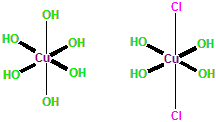
Hydroxide is a diatomic anion with chemical formula OH−. It consists of an oxygen and hydrogen atom held together by a single covalent bond, and carries a negative electric charge. It is an important but usually minor constituent of water. It functions as a base, a ligand, a nucleophile, and a catalyst. The hydroxide ion forms salts, some of which dissociate in aqueous solution, liberating solvated hydroxide ions. Sodium hydroxide is a multi-million-ton per annum commodity chemical. The corresponding electrically neutral compound HO• is the hydroxyl radical. The corresponding covalently bound group –OH of atoms is the hydroxy group. Both the hydroxide ion and hydroxy group are nucleophiles and can act as catalysts in organic chemistry.

Basic copper carbonate is a chemical compound, more properly called copper(II) carbonate hydroxide. It is an ionic compound consisting of the ions copper(II) Cu2+
, carbonate CO2−
3, and hydroxide OH−
.

Manganese dioxide is the inorganic compound with the formula MnO
2. This blackish or brown solid occurs naturally as the mineral pyrolusite, which is the main ore of manganese and a component of manganese nodules. The principal use for MnO
2 is for dry-cell batteries, such as the alkaline battery and the zinc–carbon battery. MnO
2 is also used as a pigment and as a precursor to other manganese compounds, such as KMnO
4. It is used as a reagent in organic synthesis, for example, for the oxidation of allylic alcohols. MnO
2 has an α-polymorph that can incorporate a variety of atoms in the "tunnels" or "channels" between the manganese oxide octahedra. There is considerable interest in α-MnO
2 as a possible cathode for lithium-ion batteries.
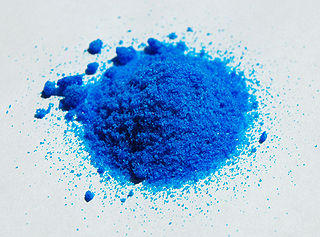
Copper(II) nitrate describes any member of the family of inorganic compounds with the formula Cu(NO3)2(H2O)x. The hydrates are blue solids. Anhydrous copper nitrate forms blue-green crystals and sublimes in a vacuum at 150-200 °C. Common hydrates are the hemipentahydrate and trihydrate.

Zinc chloride is the name of inorganic chemical compounds with the formula ZnCl2·nH2O, with n ranging from 0 to 4.5, forming hydrates. Zinc chloride, anhydrous and its hydrates are colorless or white crystalline solids, and are highly soluble in water. Five hydrates of zinc chloride are known, as well as four forms of anhydrous zinc chloride. This salt is hygroscopic and even deliquescent. Zinc chloride finds wide application in textile processing, metallurgical fluxes, and chemical synthesis. No mineral with this chemical composition is known aside from the very rare mineral simonkolleite, Zn5(OH)8Cl2·H2O.

Lead(II) chloride (PbCl2) is an inorganic compound which is a white solid under ambient conditions. It is poorly soluble in water. Lead(II) chloride is one of the most important lead-based reagents. It also occurs naturally in the form of the mineral cotunnite.
In chemistry, water(s) of crystallization or water(s) of hydration are water molecules that are present inside crystals. Water is often incorporated in the formation of crystals from aqueous solutions. In some contexts, water of crystallization is the total mass of water in a substance at a given temperature and is mostly present in a definite (stoichiometric) ratio. Classically, "water of crystallization" refers to water that is found in the crystalline framework of a metal complex or a salt, which is not directly bonded to the metal cation.

Manganese(II) chloride is the dichloride salt of manganese, MnCl2. This inorganic chemical exists in the anhydrous form, as well as the dihydrate (MnCl2·2H2O) and tetrahydrate (MnCl2·4H2O), with the tetrahydrate being the most common form. Like many Mn(II) species, these salts are pink, with the paleness of the color being characteristic of transition metal complexes with high spin d5 configurations.

Copper(I) chloride, commonly called cuprous chloride, is the lower chloride of copper, with the formula CuCl. The substance is a white solid sparingly soluble in water, but very soluble in concentrated hydrochloric acid. Impure samples appear green due to the presence of copper(II) chloride (CuCl2).

Copper(II) chloride, also known as cupric chloride, is an inorganic compound with the chemical formula CuCl2. The monoclinic yellowish-brown anhydrous form slowly absorbs moisture to form the orthorhombic blue-green dihydrate CuCl2·2H2O, with two water molecules of hydration. It is industrially produced for use as a co-catalyst in the Wacker process.

In chemistry, octahedral molecular geometry, also called square bipyramidal, describes the shape of compounds with six atoms or groups of atoms or ligands symmetrically arranged around a central atom, defining the vertices of an octahedron. The octahedron has eight faces, hence the prefix octa. The octahedron is one of the Platonic solids, although octahedral molecules typically have an atom in their centre and no bonds between the ligand atoms. A perfect octahedron belongs to the point group Oh. Examples of octahedral compounds are sulfur hexafluoride SF6 and molybdenum hexacarbonyl Mo(CO)6. The term "octahedral" is used somewhat loosely by chemists, focusing on the geometry of the bonds to the central atom and not considering differences among the ligands themselves. For example, [Co(NH3)6]3+, which is not octahedral in the mathematical sense due to the orientation of the N−H bonds, is referred to as octahedral.

In coordination chemistry, metal ammine complexes are metal complexes containing at least one ammonia ligand. "Ammine" is spelled this way for historical reasons; in contrast, alkyl or aryl bearing ligands are spelt with a single "m". Almost all metal ions bind ammonia as a ligand, but the most prevalent examples of ammine complexes are for Cr(III), Co(III), Ni(II), Cu(II) as well as several platinum group metals.
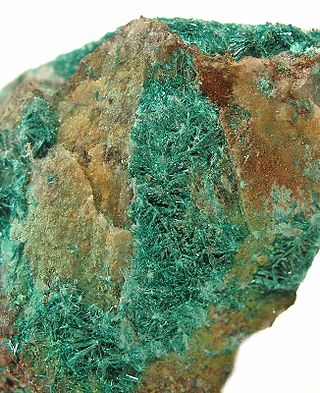
Botallackite, chemical formula Cu2(OH)3Cl is a secondary copper mineral, named for its type locality at the Botallack Mine, St Just in Penwith, Cornwall. It is polymorphous with atacamite, paratacamite and clinoatacamite.
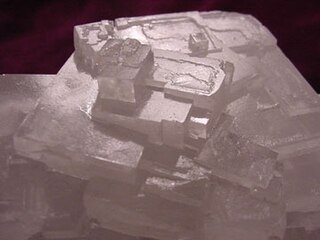
Halide minerals are those minerals with a dominant halide anion. Complex halide minerals may also have polyatomic anions.
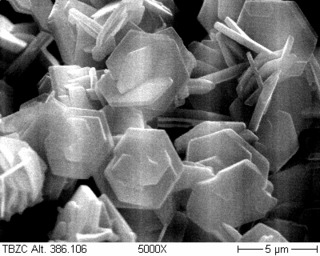
Zinc chloride hydroxide monohydrate or more accurately pentazinc dichloride octahydroxide monohydrate is a zinc hydroxy compound with chemical formula Zn5(OH)8Cl2·H2O. It is often referred to as tetrabasic zinc chloride (TBZC), basic zinc chloride, zinc hydroxychloride, or zinc oxychloride. It is a colorless crystalline solid insoluble in water. Its naturally occurring form, simonkolleite, has been shown to be a desirable nutritional supplement for animals.

Cornubite is a rare secondary copper arsenate mineral with formula: Cu5(AsO4)2(OH)4. It was first described for its discovery in 1958 in Wheal Carpenter, Gwinear, Cornwall, England, UK. The name is from Cornubia, the medieval Latin name for Cornwall. It is a dimorph of cornwallite, and the arsenic analogue of pseudomalachite.
Magnesium hydroxychloride is the traditional term for several chemical compounds of magnesium, chlorine, oxygen, and hydrogen whose general formula xMgO·yMgCl2·zH2O, for various values of x, y, and z; or, equivalently, Mgx+y(OH)2xCl2y(H2O)z−x. The simple chemical formula that is often used is Mg(OH)Cl, which appears in high school subject, for example.Other names for this class are magnesium chloride hydroxide, magnesium oxychloride, and basic magnesium chloride. Some of these compounds are major components of Sorel cement.
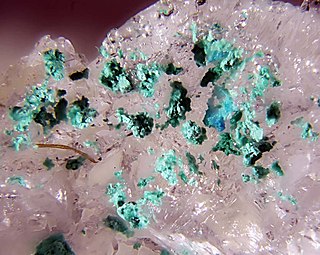
Ammineite is the first recognized mineral containing ammine groups. Its formula is [CuCl2(NH3)2]. The mineral is chemically pure. It was found in a guano deposit in Chile. At the same site other ammine-containing minerals were later found:
Chrysothallite is a rare thallium-bearing chloride mineral with the formula K6Cu6Tl3+Cl17(OH)4•H2O. Chrysothallite is unique in being only the second mineral with essential trivalent thallium, a feature shared with natural thallium(III) oxide, avicennite. Another examples of natural thallium chlorides are steropesite, Tl3BiCl6, and lafossaite, TlCl. Chrysothallite is one of numerous fumarolic minerals discovered among fumarolic sites of the Tolbachik volcano, Kamchatka, Russia The mineral is named in allusion to its colour and thallium content.
Belloite is a Halide mineral first discovered in the Rio Tinto Mine in Sierra Gorda, Antofagasta, Chile in 1998. Belloite has the ideal chemical formula of Cu(OH)Cl. The mineral has been approved by the Commission on New Minerals and Mineral Names, IMA, to be named belloite, after Andrés de Jesús María y José Bello López, the founder of the Universidad de Chile. Samples of belloite are preserved in the collection of the Mineralogical Museum in Hamburg, Germany.





